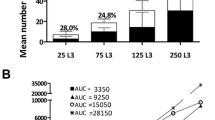Abstract
The infectivity ofEncephalitozoon cuniculi grown in cell cultures was determined in cultured cells and in wild and domestic rabbits. The ratio of the total to tissue culture viable count was 1,300 (median of seven determinations). The mean ratio of intact spore count to total count, as determined by electron microscopy was 0.12. Although variation between infectivity experiments was large, the median animal infective dose contained 51 FFU (cell culture focus-forming units) for wild rabbits (Oryctolagus cuniculus) and 40 FFU for domestic rabbits. These two infectivities were not statistically different.
Similar content being viewed by others
References
Canning EU (1977) Microsporida. In: Kreier JP (ed) Parasitic protozoa, Vol. IV Academic Press, New York, pp 155
Chalupsky J, Vavra J, Bedrnik P (1973) Detection of antibodies toEncephalitozoon cuniculi in rabbits by the indirect immunofluorescent test. Folia Parasitol (Praha) 20:281–284
Cox JC, Pye D (1975) Serodiagnosis of nosematosis by immunofluorescence using cell culture grown organisms. Lab Anim 9:297–304
Cox JC, Gallichio HA, Pye D, Walden NB (1977) Application of immunofluorescence to the establishment of anEncephalitozoon cuniculi-free rabbit colony. Lab Anim Sci 27:204–209
Cox JC, Hamilton RC, Attwood HD (1979) An investigation of the route and progression ofEncephalitozoon cuniculi infection in adult rabbits. J Protozool 26:260–265
Cox JC, Pye D, Edmonds JW, Shepherd RCH (1980) An investigation ofEncephalitozoon cuniculi in the wild rabbitOryctolagus cuniculus in Victoria, Australia. J Hyg Camb 84:295–300
Cox JC, Horsburgh R, Pye D (1981) Simple diagnostic test for antibodies toEncephalitozoon cuniculi based on enzyme immunoassay. Lab Anim 15:41–43
Furth R van, Cohn ZA, Hirsch JKG, Humphry JH, Spector WG, Langevoort HL (1972) The mononuclear phagocyte system: A new classification of macrophages, monocytes and their precursor cells. Bull WHO 46:845–852
Gannon J (1978) The immunoperoxidase test diagnosis ofEncephalitozoon cuniculi in rabbits. Lab Anim 12:125–127
Hamilton RC, Cox JC (1981) The ultrastructure ofEncephalitozoon cuniculi growing in renal tubules of rabbits. Z Parasitenkd 64:271–278
Hornick RB, Griesman SE, Woodward TE, du Pont HL, Dawkins AT, Snyder MJ (1970) Typhoid fever: Pathogenesis and immunologic control. N Engl J Med 283:686–691
Hornick RB, Music SI, Wenzel R, Cash R, Libonati JP, Snyder MJ, Woodward TE (1971) The Broad Street pump revisited: Response of volunteers to ingested cholera vibrios. Bull NY Acad Med 47:1181–1191
Owen DG, Gannon J (1980) Investigation into the transplancental transmission ofEncephalitozoon cuniculi in rabbits. Lab Anim 14:35–38
Pakes SP, Shadduck JA, Olsen RG (1972) A diagnostic skin test for encephalitozoonosis (nosematosis) in rabbits. Lab Anim Sci 22:870–877
Pakes SP, Shadduck JA, Cali A (1975) Fine structure ofEncephalitozoon cuniculi from rabbits, mice and hamsters. J Protozool 22:481–488
Petri M (1969) Studies onNosema cuniculi found in transplantable ascites tumours with a survey of microsporidiosis in mammals. Acta Pathol Microbiol Scand Suppl 204:1–91
Pye D, Cox JC (1979) Simple focus assay forEncephalitozoon cuniculi. Lab Anim 13:193–195
Shadduck JA (1969)Nosema cuniculi: In vitro isolation. Science 166:516–517
Shadduck JA, Polley MB (1978) Some factors influencing the in vitro infectivity and replication ofEncephalitozoon cuniculi. J Protozool 25:491–496
Waller T (1977) The India ink immunoreaction: A method for the rapid diagnosis of encephalitozoonosis. Lab Anim 11:93–97
Wong MC, Ewing EP, Callaway CS, Peacock WL (1980) Intracellular multiplication ofLegionella pneumophila in cultured human embryonic lung fibroblasts. Infect Immun 28:1014–1018
Wosu NJ, Shadduck JA, Pakes SP, Frenkel JK, Todd KS, Conroy JD (1977) Diagnosis of encephalitozoonosis in experimentally infected rabbits by intradermal and immunofluorescence tests. Lab Anim Sci 27:210–216
Author information
Authors and Affiliations
Rights and permissions
About this article
Cite this article
Cox, J.C., Hamilton, R.C., Pye, D. et al. The infectivity ofEncephalitozoon cuniculi in vivo and in vitro. Z. Parasitenkd. 72, 65–72 (1986). https://doi.org/10.1007/BF00927735
Accepted:
Published:
Issue Date:
DOI: https://doi.org/10.1007/BF00927735




